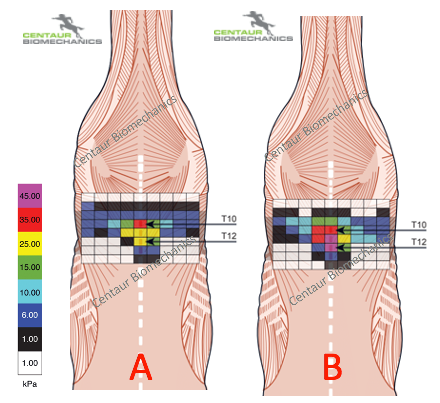
Ground schooling activities including lunging, are routinely performed in the training and rehabilitation of horses. Training rollers (from here on: roller) are commonly used to provide attachment for training aids however, little attention is given to the fit and design of the roller, and the effect it has on the horse.
It may be thought, that as there is no rider (or saddle) during lunging, the pressures beneath the roller may not be of any significance. Previously we have demonstrated (1) in trot and canter, when lunging, using a roller fitted with a wool pad and dressage square, designed with two foam pads providing a semi sort of gullet, that roller pressures were located directly on the midline of the back (spine) (Image A ). Despite no rider or saddle, the roller pressures were greater than those thought to cause back discomfort and of a similar magnitude to those seen during ridden exercise suggesting that the pressures observed are influenced by locomotor forces and roller design (1).
We should not underestimate the effect that rollers have on the locomotor apparatus of the horse, especially in horse’s who are undergoing rehabilitation for back related conditions. Pressures of this magnitude, directly on the spine are not ideal. Like saddle and bridle pressures (see previous blogs), the pressures were influenced by locomotion. In trot, two peak pressures occurred, coinciding with the stance phase of the forelimbs and in canter, one peak pressure occurred coinciding with the stance phase of the inside forelimb.
The location and magnitude of pressures beneath the roller was influenced by the training aid being used. When using side reins high pressures beneath the roller were located towards the front edge of the roller, likely due to the connection of the side rein with the roller/bit, pulling the roller forwards and down. When using a Pessoa training aid, areas of high pressures were located towards the back edge of the roller (Image B ) again, when considering the attachment of the Pessoa, attaching to a ring positioned on the back (centre) of the roller, during locomotion, the roller is tilted backwards (1).
Training aids are used for multiple reasons however, in the context of this blog, if using a training aid with a roller which is creating high pressures directly on the midline of the back, then it seems reasonable to suggest that any benefits of lunge exercise and or the training aid, are likely to be diluted. As I have said many times, horses will develop a locomotor strategy to alleviate any discomfort caused, in this case, by the roller. This is amplified when considering the already existing locomotor adaptions as a result of circling versus moving in a straight line. If we apply this to our lunge session: lunging horses on a ~20m circle, for ~15-20 minutes, in trot/canter, during each stance phase of the forelimb, a peak pressure directly on the midline of the horses back occurs, of a magnitude similar to pressures seen during ridden exercise.
Like everything else, considering roller fit and design is essential – some take home messages:
- Users should ensure that the roller is well padded providing clearance of the midline (spine).
- When using training aids, ensure that during locomotion, the training aid is not causing the roller to tilt or draw down on the horses back.
- Consider girth fit and design (see previous blog) when lunging.
Use of a correctly fitted saddle (providing there is no clinical reasoning) and positioning the roller over the top maybe advantageous.
Hope this is of interest. Please SHARE to raise awareness of the importance of training roller fit/design.
Please like our page to keep upto date with Blogs.
Kind Regards
Dr. Russell MacKechnie-Guire
www.centaurbiomechanics.co.uk
#equineresearch #biomechanics #centaurbiomechanics #veterinarymedicine #equinephysiotherapy #equinetherapist #onlinecourses #onlineseminar
1. Mackechnie-Guire R, Mackechnie-Guire E, Bush R, Fisher D, Fisher M, Weller R. Local Back Pressure Caused by a Training Roller During Lunging With and Without a Pessoa Training Aid. Journal of Equine Veterinary Science. 2018;67:112-7.